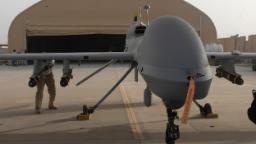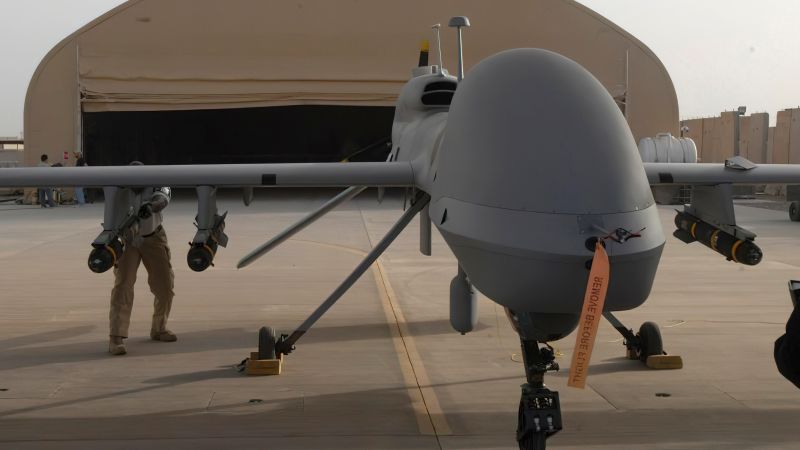
CNN
—
President Joe Biden has signed a long-awaited classified policy tightening the rules for the CIA and the Pentagon to carry out deadly drone strikes and commando raids conducted outside of traditional war zones, US officials said on Friday.
With only Iraq and Syria still considered by the US to be so-called areas of active hostilities – or conventional war zones – the new policy is geared toward countries like Somalia, Yemen and now, Afghanistan, where the US continues to carry out counterterrorism strikes from afar.
In practice, the new policy signals that the US is limiting its reliance on drone strikes, once a ubiquitous counterterrorism tool that has drawn increased criticism in recent years in the wake of a series of high-profile revelations about civilian casualties.
The new policy requires the president’s approval before a lethal drone strike or commando raid can be launched on a particular counterterrorism target, according to a senior administration official – and that individual must be named, although the policy does allow the president to waive that and other requirements at his discretion. The president must also approve which groups in which countries are considered to have potential targets as members.
The New York Times first reported on the new rules.
It also institutionalizes a series of standards for taking action against a target, including that counterterrorism operators must establish with “near certainty” that there will be no civilian casualties in the strike, and that the target poses a continuing, imminent threat to the United States.
The policy also requires operators to obtain permission from the State Department’s chief of mission in the country in question, the senior administration official said.
White House Homeland Security adviser Liz Sherwood-Randall, who spearheaded the nearly two-year review which led to the new policy, said in a statement that the guidance “directs [the Biden] Administration to be discerning and agile in protecting Americans against evolving global terrorist challenges” and “requires that U.S. counterterrorism operations meet the highest standards of precision and rigor, including for identifying appropriate targets and minimizing civilian casualties.”
In Syria and Iraq, where the US maintains a military presence, commanders in the field will continue to have more discretion on operational decisions.
Biden had quietly put in place many of the limitations that the new policy now formalizes when he took office. The policy now officially reverses a loosening of Obama-era rules under then-President Donald Trump, which had pushed authority for approving lethal strikes down the chain of command.
“I think this is overwhelmingly a return to a rigorous process, to an intel-heavy consideration of targets and [an] intense role for the president himself in approving the use of this particular tool,” the senior administration official told CNN.
Some counterterrorism operators and analysts have likely chafed at the tightened restrictions, sources familiar with the deliberations over the new rules say. But the broader shift in US priorities away from counterterrorism and toward competition with China and Russia – and the increased political scrutiny on civilian casualties – to a certain degree makes the changes inevitable, these people said.
The new policy follows a separate Pentagon initiative announced in August designed to help reduce the number of civilians killed and injured by US military operations, particular drone strikes.
The US military has been criticized for years for killing civilians in drone strikes but came under increased scrutiny after the military conducted a botched strike during the chaotic withdrawal from Afghanistan last August that killed 10 civilians, seven of them children.
The department also faced criticism over a 2019 airstrike in Syria that killed multiple civilians. The military acknowledged the deaths in that strike in November 2021, after The New York Times reported them. The department ultimately held no one accountable for the 2019 strike.
The Pentagon action plan is tasked with building a framework that will put people who are trained to consider civilian harm issues throughout the military, both in combatant commands and at more senior levels of the Defense Department.
US military drone strikes have dramatically decreased in recent years in many of the countries that the new policy impacts. According to data maintained by the Foundation for the Defense of Democracies, there have been no US drone strikes in Pakistan and Yemen since 2018 and 2019, respectively. In Somalia, US drone strikes in Somalia have dropped precipitously since Biden took office.
But although the military is required by Congress to disclose data about its counterterrorism strikes, including civilian casualties, the CIA is not – making it much more difficult to judge how its operations have shifted over time.
Some former intelligence officials take it a step further, claiming that CIA drone strikes kill far fewer civilians that the military’s – but because the agency’s figures aren’t public, and outside groups that track drone strike casualties say the US military routinely undercounts its collateral deaths, an accurate comparison is difficult to draw.
Note:- (Not all news on the site expresses the point of view of the site, but we transmit this news automatically and translate it through programmatic technology on the site and not from a human editor. The content is auto-generated from a syndicated feed.))



